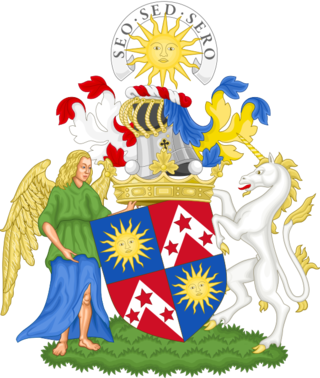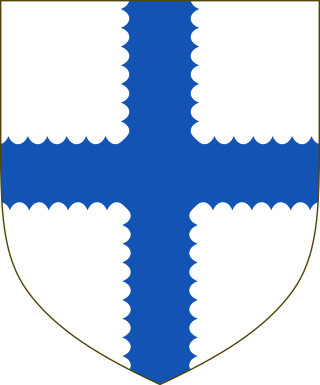| Lordship of Borthwick | |
|---|---|
 | |
| Creation date | 12 June 1452 |
| Created by | King James II of Scotland |
| Peerage | Peerage of Scotland |
| First holder | William Borthwick |
| Present holder | John Hugh Borthwick, 24th Lord Borthwick |
| Heir presumptive | Hon. Henry Borthwick of Glengelt, Master of Borthwick |
| Remainder to | the 1st Lord's heirs male of the body lawfully begotten. |
| Subsidiary titles | Hereditary Royal Falconer of Scotland Chief of the Name and Arms of Borthwick |
Lord Borthwick is a title in the Peerage of Scotland.
Contents
- Coat of arms
- Lords Borthwick (1452)
- Lords Borthwick (1452) as determined before 1986 decision
- References
- Notes
- External links
Alexander Nisbet relates that "the first of this ancient and noble family came from Hungary to Scotland, in the retinue of Queen Margaret, in the reign of Malcolm Canmore, anno Domini 1057. A Thomas de Borthwick is mentioned in a charter of Sir Robert Lauder of Quarrelwood, in the reign of King Alexander II." [1]

Sir William de Borthwick of that Ilk was created a Lord of Parliament as Lord Borthwick, (William Borthwick, 1st Lord Borthwick), but it is unclear exactly when the title was created. Nisbet states: "there appears no patent in the records constituting this peerage". [2]
Anderson [3] supposes it dates from "about 1424", Brown [4] says 1438, Leeson [5] gives 1452, and Burke's [6] and Pine [7] actually give an exact date: June 12, 1452. However, Alexander Nisbet, writing as far back as 1722 [8] states: "this family was dignified with the title of Lord Borthwick in the beginning of the reign of King James II" which commenced in 1437, which is closer to Brown's assertion.
In the Parliament of 1469 held at Edinburgh by King James III of Scotland Lord Borthwick was ranked after the Lord Halyburton (cr.1441 [9] ). In the parliament of 1471 he is the fourth Lord of Parliament ranked immediately after the Lord Glamis (cr.1445 [10] ). [11]
The chronology of the Lords Borthwick also presents problems as of the first seven, six were named William. Of the first Lord, Burke's (1999) merely states: "knighted before his father in 1430; one of the magnates who according to contemporary records habitually plundered the Customs. Married and left issue". Anderson states "the first Lord Borthwick died before 1458". [12]

His son, the second Lord (William Borthwick, 2nd Lord Borthwick), was an ambassador to England as well as Master of the Household to King James III. He was succeeded by his son, the third Lord (William Borthwick, 3rd Lord Borthwick), who some say was one of the many Scottish noblemen killed at the Battle of Flodden in 1513 although the Complete Peerage cited by Pine stated "this was unlikely". [13] His son, the fourth Lord (William Borthwick, 4th Lord Borthwick), became guardian to the infant King James V.
The ninth Lord, was a Royalist during the Wars of the Three Kingdoms. However, on his death in 1675 the male line of the third Lord failed. The Borthwick estates passed to his nephew John Dundas, son of his sister Margaret Borthwick, while the lordship became dormant.
It was to remain dormant for the next 87 years. The right to the title, however, passed to the late Lord's kinsman and male heir William Borthwick, the de jure tenth Lord. He was the son of William Borthwick, 5th of Soltray (Soutra) and Johnstonburn, elder son of William Borthwick, 4th of Soltray and Johnstonburn, great-grandson of William Borthwick, 1st of Soltray, son of the Hon. Alexander Borthwick, third son of the second Lord Borthwick. He never assumed the title.
His son, the de jure eleventh Lord, was a colonel in the army and was killed at the Battle of Ramillies in 1706. On his death the right to the lordship passed to his cousin Henry Borthwick, the de jure twelfth Lord. He was the grandson of Alexander Borthwick, younger son of the aforementioned William Borthwick, 4th of Soltray and Johnstonburn. Henry was a captain in the Scottish army and like his cousin fought at the Battle of Ramillies. He died from wounds received in action four days after the battle (and four days after his cousin). On his death the right to the lordship passed to his elder son William, de jure thirteenth Lord, and then to his younger brother Henry. The latter's claim to the title was admitted by the House of Lords in 1762, and he became the fourteenth Lord Borthwick. However, on his death in 1772 the peerage became dormant again.
The claim now passed to the late Lord's kinsman and male heir Patrick Borthwick, the de jure fifteenth Lord. He was the great-grandson of Alexander Borthwick, 1st of Reidhall and Sauchnell, younger son of William Borthwick, 3rd of Soltray and Johnstonburne, grandson of William Borthwick, 1st of Soltray, cited above. His son Archibald, the de jure sixteenth Lord, petitioned the House of Lords for the right to claim the title in 1808 but was unsuccessful. His son Patrick, de jure seventeenth Lord, was also unsuccessful when he tried to claim the title in 1816. However, his younger son Cunninghame had his claim to the lordship allowed by the House of Lords in 1870 and he became the nineteenth Lord Borthwick. From 1880 to 1885 he sat in the House of Lords as a Scottish Representative Peer. He married Alice Day, their eldest daughter was Gabrielle Borthwick, their son, the twentieth Lord, was a Scottish Representative Peer between 1906 and 1910. When he died in 1910 the peerage once again became dormant.
The claim passed to his distant relative William Henry Borthwick, the de jure twenty-first Lord. He was a descendant of John Borthwick, 1st of Crookston, younger son of the first Lord. His grandson John Henry Stuart Borthwick had his claim to the title admitted by the Lord Lyon in 1986, and he became the twenty-third Lord Borthwick. As of 2017 [update] this ancient title is held by his elder twin son, the twenty-fourth Lord Borthwick, who succeeded in 1996. He is Chief of Clan Borthwick and also holds the feudal titles of Baron of Heriotmuir and Laird of Crookston.
The family seat is Borthwick Castle, near Borthwick, Midlothian but is leased as a venue for hire by the family.













